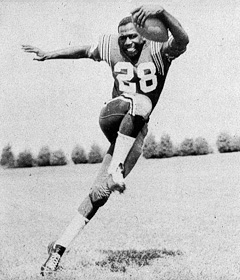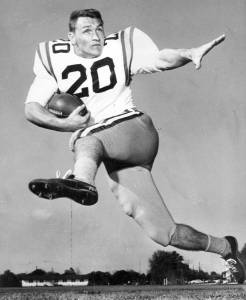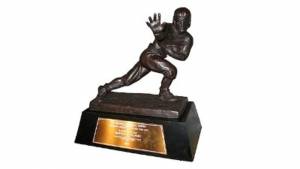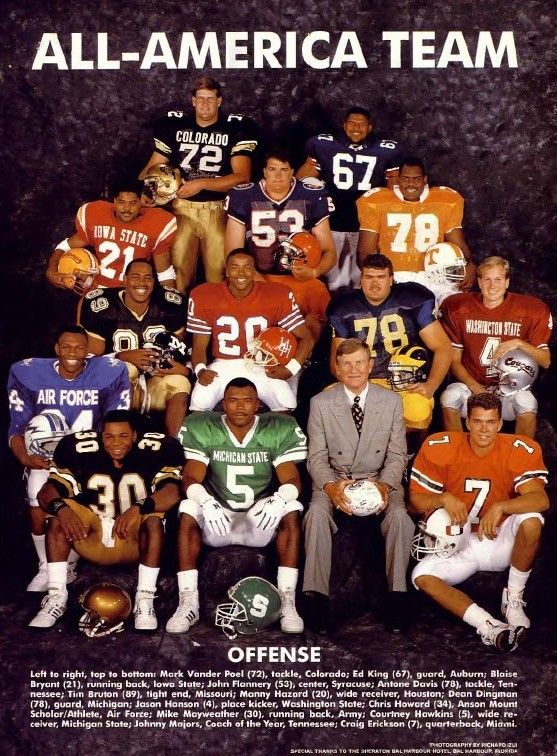Bear with me as I gaze 57 years into the past, back to the 1959 college football season. I propose to look at some numbers and hazard a supposition or two.
The big bowl games
Washington beat Wisconsin in the Rose Bowl, Georgia beat Missouri in the Orange Bowl, Mississippi beat LSU in the Sugar Bowl, and Syracuse beat Texas in the Cotton Bowl. The Orangemen were crowned ’59 national champs by both the Associated Press and United Press International. AP and UPI were then the two most prominent entities for conducting polls about the top teams and for naming All-America players, the others being the American Football Coaches Association, the Football Writers Association of America, the Newspaper Enterprise Association and Sporting News. A consensus A-A must have been chosen by all six.
My concern is that season’s running backs, not quarterbacks, receivers, linemen, kickers, et al. While I am an admitted advocate of North Texas State’s Abner Haynes, I will try to be honest and fair. I speak of yards gained, yards per carry, touchdowns and receptions, but of course there are other factors. Could the guy block? Did he fumble often? Did he come up big when the pressure was on? Was he a straight-ahead runner or elusive and able to go all the way at any time? More generally, was he a good teammate?
Degrees of greatness
 Let’s get started. The consensus All-America running backs in 1959 were Billy Cannon of LSU and Charlie Flowers of Mississippi. Five services chose Ron Burton of Northwestern and one chose Ron Mooty of Arkansas. Flowers gained 733 yards (5.2-yard average) for the Rebels and scored 11 touchdowns, garnering the fifth most Heisman Trophy votes. The Wildcats’ Burton had just 62 carries, gaining 348 yards (5.6-yard average) and scored four times. For that, five of the six chose him A-A and he came in 10th in Heisman Trophy voting? Burton benefited from playing in the Big Ten and was in Chicago, then the second-largest city in the USA. Mooty of the Hogs gained 519 yards and scored five TDs. That brings us to Cannon. The previous year, he played a major role in LSU winning the national title. Cannon was SEC player of the year and a consensus A-A in both 1958 and 1959. But check his numbers—was the great Cannon so great? As a senior, he gained 598 yards (4.3-yard average) and scored five touchdowns. He also caught 11 passes for 161 yards and had a celebrated game-winning punt return against Ole Miss. The Tigers’ runaway Heisman Trophy winner does not seem too impressive in hindsight.
Let’s get started. The consensus All-America running backs in 1959 were Billy Cannon of LSU and Charlie Flowers of Mississippi. Five services chose Ron Burton of Northwestern and one chose Ron Mooty of Arkansas. Flowers gained 733 yards (5.2-yard average) for the Rebels and scored 11 touchdowns, garnering the fifth most Heisman Trophy votes. The Wildcats’ Burton had just 62 carries, gaining 348 yards (5.6-yard average) and scored four times. For that, five of the six chose him A-A and he came in 10th in Heisman Trophy voting? Burton benefited from playing in the Big Ten and was in Chicago, then the second-largest city in the USA. Mooty of the Hogs gained 519 yards and scored five TDs. That brings us to Cannon. The previous year, he played a major role in LSU winning the national title. Cannon was SEC player of the year and a consensus A-A in both 1958 and 1959. But check his numbers—was the great Cannon so great? As a senior, he gained 598 yards (4.3-yard average) and scored five touchdowns. He also caught 11 passes for 161 yards and had a celebrated game-winning punt return against Ole Miss. The Tigers’ runaway Heisman Trophy winner does not seem too impressive in hindsight.
Dwight Nichols of Iowa State, not a first-team A-A, came in eighth in Heisman Trophy voting. He must have been quite a workhorse for the Cyclones, carrying 207 times and gaining 749 yards. Nichols’ average, 3.6 yards, is nothing to write home about.
As far as stats go, the top running backs of 1959 came from the Land of Enchantment. Pervis Atkins of New Mexico State, a junior that year, led the nation with 971 yards and in touchdowns (13). Billy Brown of New Mexico was sixth on that list with 740 yards, but he carried less often and had a splendid 7.8-yard average (7.5 for Atkins). It’s interesting to note that there were three more fine RBs in the state that year. The Lobos’ Bob Crandall gained 729 yards (6.3-yard average) and Don Perkins gained 636 yards and had eight TDs; Atkins’ teammate with the Aggies, Bob Gaiters, had the 12th best average of 5.8 yards. The next year, he would lead the nation in rushing and score a whopping 23 touchdowns.
Other running backs from 1959 who deserve mention are Prentice Gautt of Oklahoma (674 yards) and Ernie Davis of Syracuse (686 yards and a 7-yard average). Davis went on to win the 1961 Heisman Trophy, and I will not gainsay that choice.
A splendid college career, but muffled
So where does Abner Haynes fit in this picture? Near the top, no doubt. He was third in yards rushing (803), eighth in yards per carry (6.2) and second in touchdowns (11). Number 28 in green and white also caught 20 passes for 281 yards and scored three more times. I hasten to add that he ran back virtually every punt and kickoff. It is baffling that he got so little love from A-A and Heisman Trophy voters, but look a bit closer and you can see why. Not only was Haynes at an obscure school that was not in one of the power conferences, but NTSC President James Matthews was determined to muffle Haynes’ exploits. The Eagles’ football team was newly integrated, and Matthews wanted as little publicity as possible. The school had a threadbare sports information staff which was instructed not to declare that there was a spectacular player in Denton. Haynes’ college career was done “on the QT.”
every punt and kickoff. It is baffling that he got so little love from A-A and Heisman Trophy voters, but look a bit closer and you can see why. Not only was Haynes at an obscure school that was not in one of the power conferences, but NTSC President James Matthews was determined to muffle Haynes’ exploits. The Eagles’ football team was newly integrated, and Matthews wanted as little publicity as possible. The school had a threadbare sports information staff which was instructed not to declare that there was a spectacular player in Denton. Haynes’ college career was done “on the QT.”
Another point regarding Haynes is that rules mandating one-platoon football were still in force. Coaches’ decisions about how to use players seem fascinating to me here in 2016. Some quarterbacks (Richie Lucas of Penn State and Don Meredith of SMU, for example) must have been put at deep safety to avoid all the hitting closer to the line of scrimmage. Eagles coach Odus Mitchell did not have Haynes there or at any DB position. He was an outside linebacker, and a very good one, making tackles and snagging interceptions. It’s hard to say where and how well Cannon, Flowers, Atkins, Burton, Davis and others played on defense. Did their coaches stick them in the middle of the action, where Haynes was with North Texas?
The process by which football players are named All-Americans or contend for the Heisman Trophy is quite nebulous. Some are favored—and there can be no better example than Cannon—and others are disfavored. I realize that statistics can be deceiving and that there are varying levels of play in college ball; mid-level schools like North Texas are generally not considered on par with Southern Cal, Michigan, Nebraska or Alabama. But how many excellent players have come from such humble or even humbler beginnings? The list is long.
The key? Haynes
For Abner Haynes to have been almost wholly ignored by A-A and Heisman Trophy voters in 1959 is absurd. This makes clear the unfairness of the College Football Hall of Fame’s unbending rule that a guy must have been a first-team All-American to be eligible. Take a cursory glance at the 977 players now in the Hall and you will see many running backs who could not hold a candle to Haynes. Further enhancing that is his role as the first black player at an erstwhile white college in the South. Integration, from Texas all the way over to Florida and up to Maryland, was coming. Haynes was the key.


Add Comment